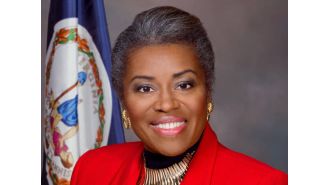Alaska’s Public Safety Officer Program Is Failing. Can It Be Saved?
A big part of Alaska’s law enforcement crisis is a program that recruits residents of remote villages and trains them to work as police. Now, a group of state legislators is proposing nine ideas to rescue the program.

A task force of Alaska legislators is proposing an overhaul of key elements of the state’s failing Village Public Safety Officer Program.
The group of legislators spent five months looking for ways to fix the 40-year-old program, which uses state money to train and pay officers working in remote villages. In 2019, the number of VPSOs fell to an all-time low of 38 — compared with more than 100 in 2012.
The inability to recruit and retain VPSOs magnifies the crippling lack of law enforcement in rural Alaska, a problem the Anchorage Daily News and ProPublica documented in depth last year. The Daily News and ProPublica found that one in three communities has no police of any kind. The Department of Justice subsequently declared the public safety gap to be a federal emergency.
In one article last fall, the Daily News and ProPublica explored the failure of the VPSO program, noting that a respected VPSO took his own life in 2005 after highlighting a lack of resources, equipment and respect for the unarmed village police force. Current officers say the same breakdowns and problems persist today.
The Alaska VPSO Working Group plans to file bills by early February that would launch nine short-term ideas for improving the program. The goal: place more certified officers in rural Alaska, increase morale among current VPSOs and retain village-based first responders who know their communities best.
According to a draft copy of the final report, the group will recommend:
The six-legislator task force proposes defining VPSO’s law enforcement powers and duties, such as conducting investigations, in state law to avoid any ambiguity. Other recommendations would remove barriers to officer travel, a suggestion experts made to the Daily News and ProPublica in December.
In one example, the task force reported that the village officers have not been allowed to attend sexual assault response team training despite Alaska having the highest rape rate in the United States.
Public Safety Commissioner Amanda Price has questioned whether the VPSO program is the right tool for providing more law enforcement in Alaska villages, given it has failed to thrive after decades of effort.
“At what point do we say maybe this doesn\'t work?” she told the Daily News and ProPublica in August.
A Public Safety spokeswoman on Wednesday declined to comment on the working group’s findings and proposals, saying the department was still reviewing the report.
When the VPSO program was launched in 1979, the officers were meant to be all-around lifesavers, handling water rescues and fighting fires as well as backing up troopers and providing basic law enforcement. But the task force claims the program has been plagued by weak and ambiguous state laws that have made it unclear what VPSOs are expected to do.
“Essentially, the current VPSO statute provides virtually no mission, vision, or statutory law enforcement duties for the program or the VPSO personnel,” the task force report says.
There are several different types of law enforcement in rural Alaska, each with different hiring and training requirements. Troopers are the best trained and best paid, working directly for the state Department of Public Safety and deployed to villages and hub cities. VPSOs receive similar initial training to that of troopers — although its length was shortened this year — and they are employed by regional nonprofits or boroughs.
The state pays for VPSO salaries through grants to the nonprofits, but much of the tension over program funding centers on whether the state should also cover costs such as housing, travel and certain equipment.
In one example highlighted by the working group, the Department of Public Safety refused to allow state grant money to be used to buy tires for a VPSO vehicle.
“Some stuff is common sense; you’re going to need it and you’re going to have to spend money,” said White Mountain VPSO Dan Harrelson, who at 67 is one of the longest-serving such officers in the state.
You can bet state troopers aren’t subject to the same spending restrictions, he said. “If they need a set of tires, they are going to get a set of tires.”
When legislators met with Price and VPSO coordinator Capt. Andrew Merrill in August, the public safety officials “made statements that the program is broken and cannot be fixed,” the task force reported.
The working group’s short-term ideas could be implemented within a year, it said. It also suggests long-term solutions including cooperative agreements among the state, tribes and federal government to fund and deliver first-responders to villages. A similar model is used to provide health care in rural Alaska.
Harrelson said the working group’s proposed changes are among several hopeful signs for the VPSO program. Several new recruits, including some from the communities they plan to serve, will soon begin training, he said.
“There’s been a couple of guys in town asking: ‘When are you going to retire? We’d like to be the VPSO,’” Harrelson said.
ProPublica and the Anchorage Daily News are investigating sexual violence in urban and rural Alaska. Here’s how you can stay in touch with us:






